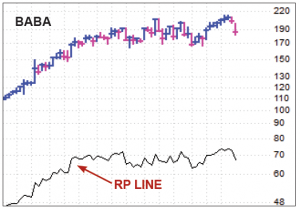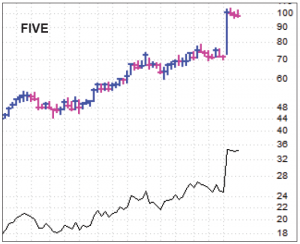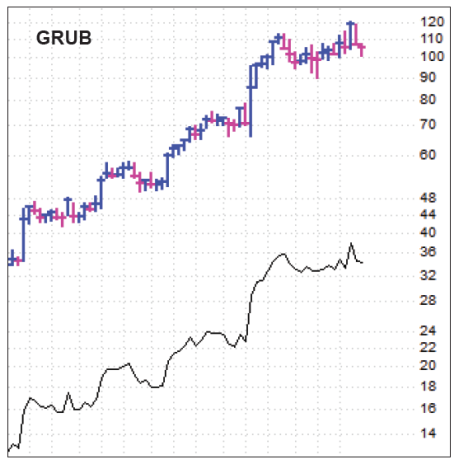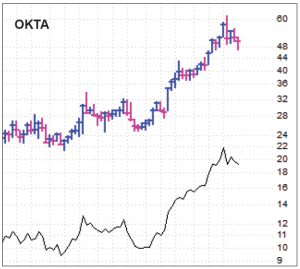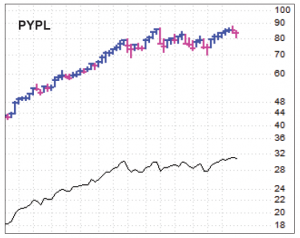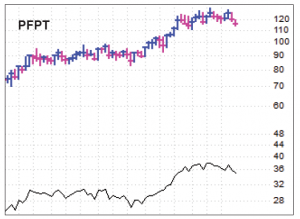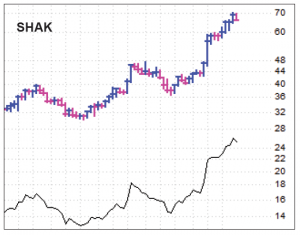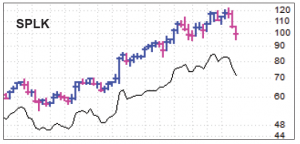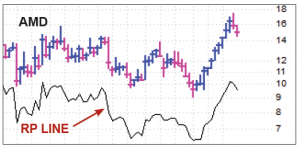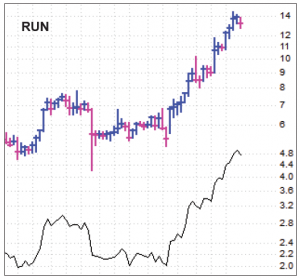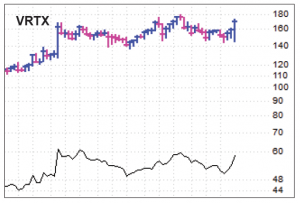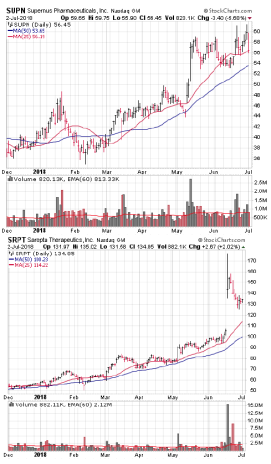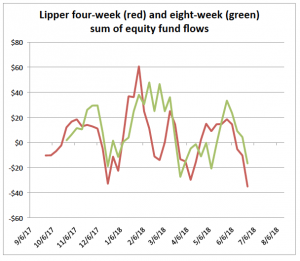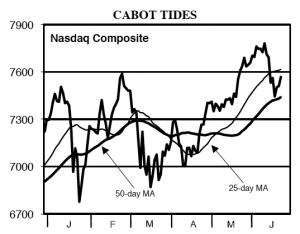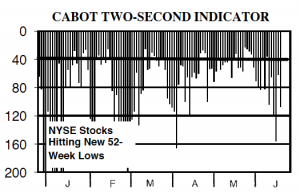When the market picture gets confusing, as it often does, it pays to have some reliable indicators to depend on—rather than the guy on the evening news. So today, after a couple of weeks of market correction that have done serious damage to some leading stocks and led many pundits to ask whether we’ve seen the market top, we turn to our indicators and ask whether the bull market is truly over, and here’s what they say...
Cabot Growth Investor 1397
[premium_html_toc post_id="152928"]
Still More Good than Bad
When you get down to it, the market is an odds game. No matter what anyone tells you, nobody can know for sure where stocks are headed, which is why the best investors are like detectives—collecting and analyzing the evidence to get a clue to which path the market is mostly likely to take going forward.
As growth stocks went vertical in June, we wrote about secondary evidence that said the risk of something violent—could be a sharp selloff, could be a rotation into defensive stocks—was rising. Sure enough, that’s what we saw during the past two weeks, with the Nasdaq falling 5% in six trading days, highfliers coming back to Earth and even some abnormal action among pockets of growth stocks. We sold two of our positions and are sitting on 40% in cash.
In other words, the market has hit a pothole. But what’s likely from here? Well, longer-term, the evidence continues to tell us this is a bull market. Our Cabot Trend Lines, which are our most reliable indicator and have been bullish since April 2016, remain positive. Plus, we haven’t seen any of the traditional bear market warning signs like fading advance-decline lines, inverted yield curves or crazy-high sentiment (the delivery man boasting about his stocks, etc.).
The short- and intermediate-term outlook for growth stocks, though, is murkier. Our Cabot Tides are on the fence, with most indexes flopping around near key levels. The same goes for leading stocks; most are in good shape and have found support near their 50-day lines, but some have decisively broken down and we can’t say there are many great entry points out there.
All told, the positive evidence still outweighs the negative, so we’re leaning bullish. However, we’re also willing to watch and wait for a little bit; this is likely one of those times where it’s better to be a couple of days late to the party than a couple of days early. Given the elevated sentiment from just a few weeks ago, some abnormal selling and the crosscurrents (low-volume holiday trading, earnings season starting soon), we’re OK waiting a couple of days for more decisive upside action.
The good news is that, should this turn out to be a short, sharp one-week shakeout, there will be plenty of names to jump on as the rally resumes. A dip like this is valuable in that it reveals the truly resilient stocks, and our Watch List has a couple of newer ideas to chew on—ideas we feel have plenty of upside left if the market gets back to its winning ways.
[highlight_box]WHAT TO DO NOW: Lean bullish. In the Model Portfolio, we sold our stakes in Alibaba and Splunk last week, leaving us with around 40% in cash. From here, we’re open to anything—prepared to raise more cash if a full-fledged correction gets underway, but we’re more focused on fine tuning our Watch List with vibrant actors.[/highlight_box]
Model Portfolio Update
Because of the yellow flags we saw in mid-June, we held off on new buying, keeping 20% on the sideline as we hunted for lower-risk entry points. Of course, those never appeared, and the past two weeks have been rough for growth stocks and the market—many May–June breakouts have failed, some stocks have shown abnormal action and our Cabot Tides are on the fence.
Because of that, the Model Portfolio’s cash level has risen to 40% based mostly on individual stock action (both BABA and SPLK look like they’ve topped for now). We’re not necessarily eager to raise more cash at this point; many stocks and indexes are hanging in there just fine. That said, we want to see the bulls step up to the plate before concluding the market’s recent dip is over.
Long story short, we’re standing pat tonight but keeping an open mind. If this was just a brief short-term pullback, there will be many growth stocks to jump on. But right now we’re keeping some relatively tight stops in place in case the sellers punish growth stocks further.
Current Recommendations
SOLD—Alibaba (BABA 185)—We believe that BABA will eventually have another leg up, as the combination of the company’s story, growth and liquidity is hard to beat. It looked like that time had come, but last week’s abnormal selling put the kibosh on that idea—shares plunged back into their prior multi-month range last week and have continued lower as worries about a slowing Chinese economy (including risks from a trade war with the U.S.) have damaged perception and raised the risk that the company’s growth will slow in the quarters ahead. (The ongoing Altaba share buyback program using BABA shares also didn’t help.) Whatever the reason, the stock’s sharp drop will likely take some time to repair, and the failed breakout and our small loss was enough to trigger a sell. We sold early last week and are holding the cash.
BUY—Five Below (FIVE 98)—Shares of Five Below continue to hold up very well, with only a little slippage seen since the stock’s massive 40%-plus rally a month ago. Beyond the cookie-cutter aspect of the story (the store count should increase about 20% annually for years, with the number of stores more than quadrupling in the long run), one thing few investors appreciate here—and the thing that initially turned us on to the stock—is the company’s store economics. We’ve studied hundreds of retail companies through the years, and the best saw the payback on their initial store investment occur in two to four years. (For example, Ollie’s Bargain Outlet has a two-year average payback, while Ulta Salon, which was a great winner for us a couple of years ago, had a four-year average payback.) But Five Below is better on this metric than any firm we can remember; it sees its investment paid back in less than one year (!), which is the underlying reason it can expand so quickly and so profitably. Back to the stock, FIVE could easily pull back further or consolidate another few weeks, but the longer it holds near its highs, the greater the chance it eventually moves higher as June’s quarterly report was likely a turning point in terms of institutional perception of the company’s growth story. Hold on if you own some, and if not, you can start a position around here.
HOLD—GrubHub (GRUB 105)—GRUB has been a bucking bronco recently, moving from 100 to 112 to 102 to 120 to 101 to 106—all within the past month! Right now, we have two thoughts. First, the stock’s wild movement and its failed breakout on heavy volume tell us the near-term could be challenging; we’re sure the market will have an impact, but the action tells us that, at the very least, there are still sellers looking to take profits on strength. Longer-term, though, we remain optimistic. The fact that the stock has corrected a maximum of 20% during the past few months despite its giant prior run and the on-again, off-again market environment is a sign that the next big move is up. We changed our rating back to Hold when the breakout failed and will give our small position plenty of rope.
HOLD—Nutanix (NTNX 52)—NTNX looked pristine two weeks ago, but like so many growth stocks, shares took a big hit afterwards, falling back toward their lows of March and April. At this point, we’re fine with NTNX and want to give it room; we still think it has the makings of an emerging blue chip stock, and it’s possible the stock needed a “real” shakeout given that it hadn’t had one in a few months. If shares hold up around here (as they have since the selloff early last week), there’s no reason that NTNX can’t round out a normal launching pad in the weeks ahead. That said, we’ll just follow our plan—given the selloff and the fact that we have a loss, we’re holding for now but using a relatively tight mental stop in the 47 to 48 area.
HOLD—Okta (OKTA 51)—OKTA is generally holding its 50-day line, which is actually better than a lot of growth stocks; this is basically the stock’s first test of that key intermediate-term moving average since getting going in March (you could argue April was another), which should offer support. Fundamentally, we don’t think anything is wrong here—our guess is that growth (which has been in the 60% range in recent quarters) could continue to outpace expectations as the firm’s identity solutions address a giant corporate market. Basically, if you’re a company moving to the cloud and want to improve, secure and transform the customer experience, Okta’s products will help. In the most recent quarter alone, the firm’s customer count rose 40% from a year ago, while the number of clients with over $100,000 of annual recurring revenue lifted 52%. That said, we’re about breakeven on the stock at this point, and a decline into the mid 40s or so (decisively below the 50-day line) would probably have us bailing. Right now, though, we’re grinding our teeth and giving OKTA a chance to hold up.
BUY—PayPal (PYPL 83)—PayPal has been busy on the acquisition front during the past couple of weeks. The big one was the $2 billion-plus buyout of iZettle, which greatly expanded the company’s international abilities. Late last month, it bought Hyperwallet for $400 million in cash, boosting PayPal’s suite of payment solutions to both e-commerce platforms and marketplaces. And then it spent $120 million (cash, not shares) to buy Simility, a fraud prevention and risk management platform for merchants. We’re not experts on the ins and outs of all these companies, but it’s a safe bet they’ll continue to build up PayPal’s moat, making the service more attractive to both merchants and consumers. As for the stock, it toyed with new-high ground before being pushed back into its base last week, but we don’t see anything unusual given the market’s weakness. The longer-term trend is positive and we believe the next big move will be on the upside. Hang on if you own some, and you can grab shares around here if you don’t.
HOLD—Proofpoint (PFPT 116)—PFPT has been tickling support (and our mental stop) in recent days, but so far is holding up. Overall, the stock has done a whole lot of nothing during the past couple of months, and there’s been a dearth of news from the company, too. But we’re willing to follow the plan because the potential is still big—just among Proofpoint’s current customer base, management believes it has a $1 billion cross-selling opportunity (double last year’s revenue total), and of course that potential doesn’t include new customer wins every quarter. We think we’ll find out whether the stock has been playing possum during the past few months in the near future—a dip to the 113 to 114 area will likely have us moving on, but we continue to advise giving your position a chance to get going as long as shares hold above there.
BUY—Shake Shack (SHAK 66)—SHAK has finally begun to pull back, with its dip earlier this week touching its 25-day line for the first time in a couple of months. While the stock could retreat more (the 50-day line is nearing 60) as some sellers might look to take profits in the resilient retail sector, we think the dip marks a good buying opportunity. SHAK just began what we think will be a sustained uptrend in early May, so barring a market meltdown, there are probably lots of big investors looking to fill out their position on weakness. Hold on if you own some, and if you don’t, you can buy some around here.
SOLD—Splunk (SPLK 99)—We were planning on selling half of SPLK if it broke below 110 or so (which it did on June 22), but we decided to sell it all when we saw the action—after stalling out for weeks, shares were crunched on three days of extremely heavy volume, which raises the odds of a longer-lasting peak. We’re not predicting anything, but our solid profit was shrinking and the stock’s action suggests there will be better names to own going forward. We sold our position last Monday.
Watch List
Carvana (CVNA 42): It’s a bit thin and very volatile, but Carvana has a giant story, triple-digit revenue growth and the stock just got going a few weeks ago from a huge post-IPO base.
Ligand Pharmaceuticals (LGND 212): LGND actually rallied to new highs on heavy volume last week after receiving a good-sized milestone payment. LGND is one of many biotech stocks that are acting well and showing big growth; see page 6 for more.
Spotify (SPOT 169): SPOT has been pushed and pulled by the market recently, but it’s holding up just fine, especially compared to other IPOs. This is a big, mass-market growth story.
Teladoc (TDOC 60): We’ve had mixed success with medical stocks, but TDOC is the hands-down leader in an entirely new industry (virtual care) that should grow rapidly for many years. The stock has pulled back normally after a big run.
Vertex Pharmaceuticals (VRTX 168): VRTX is another biotech stock we have our eye on—it has big earnings estimates and a big launching pad. See page 6 for more.
Wayfair (W 116): We’re not sure we want to own another retail play, but Wayfair has shown intriguing strength lately, and the firm’s consistent growth and growing brand name add to the attraction.
Other Stocks of Interest
The stocks below may not be followed in Cabot Growth Investor on a regular basis. They’re intended to present you with ideas for additional investment beyond the Model Portfolio. For our current ratings on these stocks, see Updates on Other Stocks of Interest on the subscriber website or email mike@cabotwealth.com.
Advanced Micro Devices (AMD 15) — Advanced Micro Devices used to be a microchip designer and manufacturer, but got rid of its last manufacturing interests in 2012 to focus exclusively on the design end of the chip business. It took a long time for the strategy to bear fruit, and the company lost money in 2015 and 2016. But 2016 also brought a monster rally in AMD, which soared from below 2 in January to 12 in December. Then, after a year of roller-coaster action, AMD caught another uptrend in April 2017 after a quarterly report that reflected a 40% increase in revenue and a stunning 1,000% increase in EPS. The chip business is always cyclical and iffy, but Advanced Micro’s chips target many fast-growing areas like servers, gaming consoles and even cryptocurrency mining, and news that major competitor Intel might be having manufacturing problems also improved investors’ perception. After a year of being tossed in the surf, AMD could be an early-stage winner.
Sunrun (RUN 14) — Installing and leasing solar energy systems on residences is a tough way to make a living, as Tesla has found out the hard way with its SolarCity acquisition. But Sunrun, a small California-based solar company with operations in 22 states, seems to have found the sweet spot. The company installs solar systems (including batteries for power storage) on customers’ homes and contracts to sell them electricity for a 20-year initial term. The company turned profitable in 2016 and has enjoyed after-tax profit margins in the high teens for the last four quarters. RUN has made a huge cup formation since its IPO at 10 in 2015, running downhill to a base between 4 and 5 through much of 2017 and starting a rally in February 2018 that has carried the stock to 14 in recent trading. This is a smaller, speculative stock, but there’s big growth here and a resilient chart.
The Trade Desk (TTD 91) — The Trade Desk is a young, technically sophisticated company that gives advertisers the tools to manage their own campaigns via display, social, mobile and video advertising. This is a data-driven concept that uses information about consumer behavior to target and deliver ads and measure their effectiveness with precision. The company is still relatively small, but the concept is big, and revenue growth has been rapid, up 52% in 2017 and 61% in Q1. Earnings are also growing quickly, up 89% in Q1, with analysts’ estimates for 24% growth this year and 21% in 2019. The idea of programmatic advertising is gaining traction quickly, and The Trade Desk, whose stock blasted off on monster volume on May 11 after a winning quarterly report, is a clear leader.
Vertex Pharmaceuticals (VRTX 168) — Vertex Pharmaceuticals specializes in treatments for cystic fibrosis and has three approved treatments—Orkambi, Kalydeco and Symdeko—on the market and a full pipeline of candidate drugs in clinical trials. The company has been consistently profitable since Q4 2015, and enjoys great support from a ton of institutional sponsors. VRTX pushed out to a new all-time high at 178 in March, then corrected back to 145 in June. But the pop in VRTX from 148 to 172 on June 29 came courtesy of a mediocre clinical trial report for rival Galapagos’ CF drug and news that AbbVie was opting out of the CF race. If VRTX can follow through on that high-volume breakout, it could start a sustained run.
A New Wave of Biotech Stocks
Over the past decade or so, the biotech group basically consisted of two types of companies—either big, older firms (think Amgen) that weren’t growing very fast, or on the other side of the spectrum, totally speculative outfits that not only lacked earnings, but had no revenues, either. No thanks!
Occasionally there was a nice in-between situation (Celgene had great numbers and a great run a few years back), but most of the time it was split between these two extremes.
Now, though, we’re starting to see a few of these smaller biotechs grow up. While the valuations are still big, products are hitting the market, revenues are growing rapidly and there remain huge prospects for growth as new drugs and treatment options are approved.
Ligand Pharmaceuticals (LGND) is one of our favorites in the group, with a unique licensing business model and research platform that’s bringing in ever-growing royalties and milestone payments that produce big earnings (north of $6 per share this year); more licensed treatments should hit the market in the quarters ahead. The stock burst to new highs on great volume last week after announcing a good-sized payment from Wuxi Pharmaceuticals, which expanded its use of Ligand’s research assets.
Supernus Pharmaceuticals (SUPN) focuses on treatments for central nervous system diseases. It has two products on the market for various types of seizures, migraines and epilepsy. Revenues are expected to leap 33% this year and more than 20% (likely conservative) next, with earnings up 50% this year and 37% next. And it has four Phase III trials starting for a potential blockbuster ADHD treatment, too; data will start rolling out next year. The stock broke out powerfully in May and, despite a wobble this week, is still acting normally.
Then there’s Sarepta Therapeutics (SRPT), which has treatments for Duchenne muscular dystrophy, a very rare (one in 4,000 or so males has the disease), fatal disease caused by gene mutation. Its one gene therapy product on the market is growing rapidly (sales should nearly double this year), and recent positive trial results (and orphan drug status) for another Duchenne treatment sent the stock to the moon. Admittedly, SRPT has had a huge run, but it’s worth watching to see how it handles itself as the market pulls in.
Whether it’s these three or others, we’re starting to see more biotech firms fit our stock picking criteria—not just a good story, but also real growth numbers and a solid chart. It’s an area worth watching for leadership going forward.
On the Other Hand …
In the last issue, we wrote a bit about how some sentiment measures had gotten stretched to the upside—many options measures (such as the CBOE equity put-call ratio) were at their lowest (most complacent) levels since at least January and, often, among the lowest in years. While everyone points to the news (trade war, etc.), we don’t think it’s a coincidence the market’s recent skid began when investors were extremely optimistic.
On the other hand, many money flow measures never became extreme. Last issue, we mentioned the level of bullish assets in Rydex funds, which was nowhere near the extreme readings from earlier this year. And, a broader view—including all inflows (or outflows) to equity mutual funds and ETFs—reveals investors bailing out in a hurry.
Shown here are the four-week (in red) and eight-week (in green) sums of money flows to equity funds and ETFs. We’ve only been tracking the data (from Lipper) since last September, but the recent data looks relatively extreme—the four-week sum (through June 27) is at its lowest level in at least nine months, and the eight-week tally isn’t far behind! We’d note that the prior two dips to the current level in the four-week tally (December 20 and April 11) preceded solid market rallies, and the skyscraper peak in this metric occurred in late January, just as the market was hitting its high for the year.
Of course, no sentiment measure is ever going to outweigh what’s actually happening in the market (trends of the indexes, action of leading growth stocks), but we’re intrigued by the potential for something like this to highlight periods when market risk is higher or lower than normal; we like that it’s actual money flows (not opinions or surveys) and that it’s very broad (all equity funds and ETFs). We’ll continue to track it and see how this indicator “performs” going forward—if it proves its worth we could incorporate it into our market timing system. We’ll keep you posted.
Cabot Market Timing Indicators
The sellers have made a stand recently, driving not just most indexes lower but also hitting leading stocks hard. It’s not the end of the world, but with some growth stocks taking hits and our Cabot Tides on the fence, we’re holding some cash and taking things on a stock-by-stock basis.
Cabot Trend Lines: Bullish
Our Cabot Trend Lines have taken a hit along with the market during the past two weeks, but the buy signal remains in effect—last week, the S&P 500 (by 0.8%) and Nasdaq (by 4.4%) both closed above their respective 35-week moving averages. A Sell signal occurs when both indexes close two straight weeks below their 35-week lines. Anything is possible, but right now, the longer-term trend is pointed up, so the odds favor higher prices for this bull market in the months ahead.
Cabot Tides: On the Fence
Our Cabot Tides are on the fence, with most indexes a bit above or below their lower (50-day) moving averages. Of course, some indexes have been range-bound since late January, but even the stronger ones (like the Nasdaq, shown here) have pulled in during the past couple of weeks. We’ll be watching closely to see if buyers step up; if not, the intermediate-term trend could turn down.
Two-Second Indicator: Unhealthy
The Two-Second Indicator remains unhealthy, as it has for months, as the number of stocks hitting new lows can’t get below 40 consistently. And it’s not just because of bond funds and preferred stocks, either—the number of common stocks hitting new lows reached 79 during the peak of last week’s selling. Combined with the divergences among the indexes, this indicator continues to tell us the broad market isn’t in great health.
[premium_html_footer]
Send questions or comments to mike@cabotwealth.com.
Cabot Growth Investor • 176 North Street, Post Office Box 2049, Salem, MA 01970 • www.cabotwealth.com
All Cabot Growth Investor’s buy and sell recommendations are made in issues or updates and posted on the Cabot subscribers’ website. Sell recommendations may also be sent to subscribers as special bulletins via email and the recorded telephone hotline. To calculate the performance of the portfolio, Cabot “buys” and “sells” at the midpoint of the high and low prices of the stock on the day following the recommendation. Cabot’s policy is to sell any stock that shows a loss of 20% in a bull market (15% in a bear market) from our original buy price, calculated using the current closing (not intra-day) price. Subscribers should apply loss limits based on their own personal purchase prices.
Charts show both the stock’s recent trading history and its relative performance (RP) line, which shows you how the stock is performing relative to the S&P 500, a broad-based index. In the ideal case, the stock and its RP line advance in unison. Both tools are key in determining whether to hold or sell.
THE NEXT CABOT GROWTH INVESTOR WILL BE PUBLISHED JULY 18, 2018
We appreciate your feedback on this issue. Follow the link below to complete our subscriber satisfaction survey: Go to: www.surveymonkey.com/marketlettersurvey
Neither Cabot Wealth Network nor our employees are compensated by the companies we recommend. Sources of information are believed to be reliable, but are in no way guaranteed to be complete or without error. Recommendations, opinions or suggestions are given with the understanding that subscribers acting on the information assume all risks. © Cabot Wealth Network. Copying and/or electronic transmission of this report is a violation of U.S. copyright law. For the protection of our subscribers, if copyright laws are violated, the subscription will be terminated. To subscribe or for information on our privacy policy, call 978-745-5532, visit www.cabotwealth.com or write to support@cabotwealth.com.
[/premium_html_footer]



